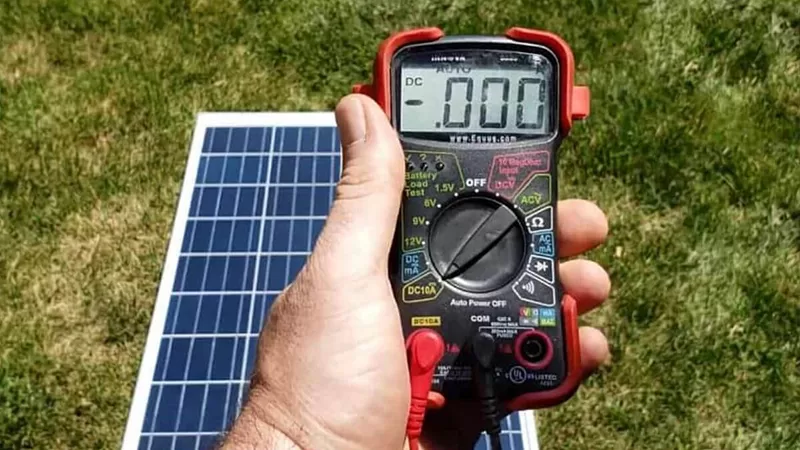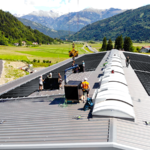When choosing solar panels, quality is key for system performance and durability. With many options available, selecting high-quality panels can be challenging. This article outlines practical methods for assessing panel quality—appearance checks, label verification, and electrical measurements—to help you make informed decisions. These steps will enhance your purchase choices and ensure efficient, reliable photovoltaic system performance.
Inspecting Appearance
Check the Color: Efficient monocrystalline silicon solar cells are typically a uniform black, while polycrystalline silicon cells are usually a consistent light blue or sky blue. If the panel’s color is dull or inconsistent, it likely indicates poor craftsmanship.
Examine the Surface: The tempered glass surface of the panel should be smooth and free from foreign objects. Some manufacturers may neglect to clean silicone droplets from the glass surface, which can impact energy generation efficiency.
Inspect the Cells: Solar panels should consist of intact cells cut from a single piece. Many unregulated manufacturers use broken cells pieced together, which can result in disconnections over time. Look for any signs of cutting marks to identify such issues. Although these problems are hard to detect with the naked eye, they pose significant risks as the panel ages.
Check the Back: Examine the back of the panel for any irregularities after applying pressure, such as bubbles or wrinkles.
Inspect the Frame: Due to the low entry barrier in the solar panel industry, many small manufacturers use manual framing, which can result in uneven framing and poor fitting. Modern panels usually feature aluminum alloy frames for better durability.
Examine the Silicone: Ensure the silicone around the edges of the back panel is evenly distributed and securely fills the gaps between the back panel and the frame.
Check the Soldering: Inspect the soldering of the cells for any signs of poor workmanship, such as incomplete soldering. Also, check if the cell arrangement is orderly.
Inspect the Junction Box: Finally, verify that the junction box is securely attached and that its cover fits tightly. Check if the wire connectors rotate smoothly and can be tightened effectively.
Compare Prices: If distinguishing the quality through the above methods is challenging, comparing prices can be a useful approach. Although international solar panel prices fluctuate, there is a general range. If a manufacturer offers a price significantly below market value, it warrants further scrutiny.
In conclusion, there are many aspects to consider when evaluating the quality of solar panels. The points mentioned above are useful for non-professionals to assess panel quality without specialized equipment. However, some quality issues may not be visible to the naked eye or may become apparent only after some time. To safeguard your interests, it is advisable to have panels tested by professional institutions.
Checking Labels
When purchasing photovoltaic panels, checking the labels on the panels is crucial. These labels help you quickly identify the panel’s brand, model, and certifications, which aids in selection and comparison.
- Brand Identification (Manufacturer or brand name of the solar panel)
- Model Identification (Solar panel model or specifications)
- Certification Marks (Standards the solar panel has passed, such as TUV, IEC, CE, etc.)
If the solar panels lack these markings, special attention should be paid to their quality and performance. Some solar panel brands may place labels on the front or back of the panel, showing important parameters like voltage, current, power, etc. If these parameters are available, they can be measured to verify if they meet the performance requirements of the panel.
Measuring Parameters
To assess the performance of a solar panel, you can measure several electrical parameters. When selecting photovoltaic panels, measuring the open-circuit voltage (Voc), short-circuit current (Isc), maximum power point voltage (Vmp), and maximum power point current (Imp) can help evaluate their performance. Here are the steps to perform these measurements:
- Prepare Tools: You will need a multimeter, safety gloves, and a solar panel.
- Measure Open-Circuit Voltage (Voc):Set the multimeter to DC voltage mode, connect the positive and negative leads to the corresponding terminals on the solar panel, and read the displayed value.
- Measure Short-Circuit Current (Isc): Set the multimeter to DC current mode, connect the positive and negative leads to the corresponding terminals on the solar panel, and read the displayed value.
- Measure Maximum Power Point Voltage (Vmp) and Current (Imp): Connect a variable resistor (load) to the panel, adjust the resistor until the reading on the multimeter reaches its maximum, and record the voltage as Vmp and the current as Imp.
When measuring parameters, follow safety guidelines, such as wearing safety gloves to prevent electrical shock. If the measurement results align with the manufacturer’s specifications, it indicates stable performance and good quality of the photovoltaic panel.

Conclusion
By using the methods outlined above, you can conduct a preliminary assessment of solar panels to help make an informed purchasing decision. Appearance checks, label verification, and electrical parameter measurements are effective ways to ensure the quality of photovoltaic panels. However, some potential issues may require professional testing to uncover. When selecting solar panels, be sure to choose a reputable supplier and consider professional testing to protect your investment. High-quality panels not only enhance system efficiency but also ensure long-term stability and reliability, providing a solid foundation for your sustainable energy solutions.
Since its establishment in 2008, Maysun Solar has specialized in producing high-quality photovoltaic modules renowned for their exceptional performance and modern design, perfectly integrating with various buildings. We develop customized solutions based on Europe’s unique geographical and climatic conditions. Whether it’s high-temperature-resistant IBC, HJT, and TOPCon solar panels, or innovative balcony stations designed for small households, our products are highly favored by customers. With over 16 years of industry experience and certifications from authorities such as TUV and CE, Maysun Solar offers premium photovoltaic products with an annual production capacity of up to 2 GW, ensuring a stable supply. For the latest module quotes or any photovoltaic-related inquiries, please feel free to contact us. We look forward to assisting you.
Reference:
4 steps to quickly identify the quality of solar panels. (n.d.-b). inverter.com. https://www.inverter.com/4-steps-to-quickly-identify-the-quality-of-solar-panels?srsltid=AfmBOooarJJFgn1bt4fCeRPhQuKZcrVPSyVgRGIl-JJQe2a_Qm7tRD1S
Solarmodule testen: Qualitätskontrollen für Panels. (n.d.). Solarenergie: Informationen Zu Photovoltaik Und Mehr. https://solarenergie.de/solarmodule/solarmodule-testen
You may also like:

Empowering Factories with Solar Energy A Strategic Tool for Controlling Production Electricity Costs
Commercial and industrial solar is becoming a key solution for factories to reduce electricity costs and hedge against price fluctuations. This article systematically analyzes its deployment models, cost advantages, and sustainable value pathways.

How Businesses Can Offset Carbon Taxes with Solar Power
This article analyzes the latest carbon tax policies and photovoltaic deduction strategies, helping European businesses legally reduce taxes, increase profits through solar investment, and achieve a win-win situation for both economy and environment.

Forecast and Response: Seizing the Next Decade’s Growth Dividend in Europe’s Commercial and Industrial Photovoltaics Market
Maysun Solar analyzes the growth trends of commercial and industrial photovoltaics in Europe over the next ten years, from policies and ESG to technological innovation, helping companies seize the initiative in the energy transition.

How to Calculate Solar System ROI and Optimize Long-Term Returns?
Solar power is becoming a key solution for businesses to reduce costs and improve efficiency. Accurately calculating ROI and optimizing long-term returns are essential to maximizing investment value.

Will Agrivoltaics Affect Crop Growth?
Agrivoltaics combines solar energy and agriculture to reduce up to 700 tons of CO₂ per MW, improve water use, and boost crop growth for sustainable farming.

6.5 Billion Loss Hits Photovoltaics: Reshaping or Elimination?
In 2025, the photovoltaic market may see a turnaround as some companies take early action. A €6.5 billion loss is driving businesses to explore new growth areas like energy storage and hydrogen. Which giants will break through? Industry transformation is accelerating!



